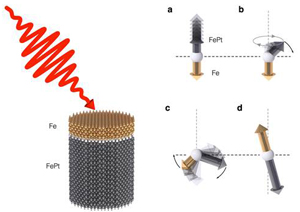York physicists pave the way for more energy efficient technology
Posted on 28 February 2014

Magnetic materials are currently used to store almost all digital information. However, with information processing and storage now making up a significant fraction of the world’s energy consumption, continuing improvements in energy efficiency will require new technologies and materials.
A promising development is all-optical thermally induced magnetic switching (TIMS), which uses ultrafast laser pulses to change the magnetic state of the material, equivalent to writing a single bit of data. In all-optical switching there is no need to use magnetic fields to write the data and so a significant reduction in power consumption can be made. Moreover, the deposited laser energy per written bit is much smaller.
Until now, only rare-earth-transition-metal alloys called ferrimagnets have been shown to exhibit all-optical switching. However, these materials are both difficult to produce at the nanoscale necessary for technological devices and expensive due to their use of rare-earth metals such as Gadolinium (Gd) and Terbium (Tb).
Now new research, led by York’s Department of Physics and involving scientists from Helmholtz-Zentrum Berlin (HZB), Germany and Radboud University Nijmegen, the Netherlands offers a new possibility for all-optical switching.
The research, published in Applied Physics Letters, demonstrates the use of a synthetic ferrimagnet - a sandwich of two ferromagnetic materials and a non-magnetic spacer layer. The spacer layer engineers the coupling between the two ferromagnets so that they align opposite to one another. When subjected to an ultrafast laser pulse this structure spontaneously switches its magnetic state representing writing a single bit of data.
Corresponding author Dr Richard Evans, from York’s Department of Physics, said: “Energy efficiency is one of the most important goals for technological devices due to their expanding use with an increasing world population and resultant demand for energy.
“The synthetic ferrimagnet structure overcomes the intrinsic problems of rare-earth-transition-metal alloys and paves the way for a new class of magnetic materials and devices with improved performance and power efficiency. The results are a significant step towards realising a device based on thermally induced switching as it shows that structures on the nanometre length scale can be used.”
Co-author Professor Theo Rasing, Head of the Department Spectroscopy of Solids and Interfaces at Radboud University Nijmegen, said: “Since our original discovery of all-optical-switching of magnetic domains in these ferrimagnetic alloys more than five years ago, the fruitful collaboration between our experimental efforts, the possibilities provided by the unique instrumentation of the Helmholtz-Zentrum and the theoretical insight provided by the York team, has led to this truly European success.”
The research received financial support from the EU Seventh Framework
Programme, as well as the Netherlands Organization for Scientific Research (NWO) and the Foundation for Fundamental Research on Matter (FOM).
Notes to editors:
- The article ‘Ultrafast thermally induced magnetic switching in synthetic ferrimagnets’ is published in Applied Physics Letters at http://scitation.aip.org/content/aip/journal/apl/104/8/10.1063/1.4867015 Authors: Richard F. L. Evans, Thomas A. Ostler, Roy W. Chantrell, Ilie Radu and Theo Rasing.
- A schematic diagram of all-optical thermally induced magnetic switching using synthetic ferrimagnets is available from the University of York Press Office. Email: pressoffice@york.c.uk or +44 (0)1904 322029.
- A synthetic ferrimagnet has two essential components: the first is the engineered structure, consisting of two magnetic layers and a spacer – the ‘synthetic’ part; the second is the magnetic properties of the two layers – the ‘ferrimagnet’ part. A ferrimagnet consists of two materials with different magnetic moments which are aligned anti-parallel. In intrinsic ferrimagnets, each atomic species (eg Gd, Fe) has a different magnetic moment, and so one of the species is magnetically dominant.
In a synthetic ferrimagnet, each of the layers has a different magnetic moment due to the different layer thickness, even though the constituent atoms may be the same. In addition the coupling between the layers must be specially engineered to give anti-parallel alignment of the layers. The force that controls the alignment of the magnetic moments is called the exchange interaction, which arises due to the overlap of atomic orbitals and is the strongest force in magnetism. Some materials prefer to have parallel moments, while others prefer anti-parallel moments. However, the exchange interaction is long-ranged and oscillatory, and so if two magnetic materials are separated by just the right amount, it is possible to control the strength and preferred orientation of the exchange coupling. - All-optical magnetic switching is a complicated effect, which arises due to the interaction of light and a magnetic material. The details of the physical mechanism are still hotly debated, but we do know that the effect is driven by a combination of ultrafast heating due to the laser and the particular dynamic properties of the material.
When the laser pulse hits the magnetic material, the electrons in the material heat up over the course of a few hundred femtoseconds (a millionth of a billionth of a second). When this happens the atomic magnetic moments begin to lose their order, an effect known as demagnetisation. In ferrimagnets, the two materials have different dynamic properties, and so demagnetisation occurs at a different rate for each atomic species – this fact is crucial to the thermally induced switching process.
The different demagnetisation rate of each magnetic species induces a complex motion of the magnetisation, where for a short time the magnetic moments are aligned in parallel. At the end of this process the orientation of the magnetic moments has changed, representing a change in the magnetic state of the material. - For more information on the University of York’s Department of Physics visit www.york.ac.uk/physics
Contact details
Keep up to date
Subscribe to news feeds
